Last updated on December 3rd, 2024 at 04:30 pm
It’s downright fascinating how kitchens have transformed over the last 100 years in America. From their beginnings as little more than functional spaces for cooking to the bustling heart of our homes, the evolution of the kitchen is truly a modern miracle.
So, what exactly do we mean by an American-style kitchen? Essentially, it’s a place crafted for practicality, socializing, and, of course, unleashing your culinary imagination.
Our journey through kitchen history starts with the word “kitchen” itself, which hails from the Old English term “cycene,” rooted in the Latin “coquina.” Back in the day, kitchens were mainly outdoor settings with crackling open fires. It wasn’t until the late 1800s that technological advancements and architectural shifts ushered kitchens into the mainstream household fold.
Every decade seemed to bring something fresh while borrowing a bit from the past—a touch of nostalgia or perhaps a dash of disdain for the kitchen styles we grew up with. These evolving influences have seeped into the design choices that decorate our kitchens today, often without us even realizing it. Here’s a stroll down the timeline to explore how each era shaped our kitchens, weaving the past into the fabric of our modern-day living spaces.
The Heart of the Home: The American Kitchen

The kitchen’s evolution into the heart of the American home is a journey of innovation and cultural transformation. Kitchens started out as outdoor spaces where meals were cooked over open fires, but the arrival of indoor plumbing and the introduction of stoves in the late 19th century, the kitchen began to take a center stage in domestic life.
The American-style kitchen, characterized by its open layout, emerged as a versatile space designed not only for culinary tasks but also for socializing. This integration with living and dining areas made kitchens more than just a functional workspace—they became gathering spots that brought families and friends together.
As our cooking styles expanded to embrace a world of flavors, our kitchens adapted too, with innovations like the trusty kitchen cabinet making everything feel a bit more organized and efficient. But more than that, the kitchen has come to mean much more than mixing bowls and oven mitts. It’s where life happens—where family stories are swapped, new recipes are tried out, and where we gather to celebrate or just unwind after a long day. Truly, the kitchen has taken center stage as the heart of the home, blending culinary inspiration with everyday living in the most delightful way.
The concept of the “kitchen cabinet” popped up during Andrew Jackson’s presidency. This term refers to an informal group of advisors, and it’s a bit like those cozy chats we have in our own kitchens. It perfectly captures the blend of personal warmth and serious decision-making. So, next time you’re whipping up a meal, remember: your kitchen isn’t just for cooking; it’s also a hub for comfort and clever ideas!
Who knew that your favorite room could play such a big role in history?
The American kitchen’s journey mirrors societal shifts, adapting to technological changes and cultural influences, solidifying its status as the true heart of the home.
The Decades of Transformation
1900-1920: A Modern Idea Begins
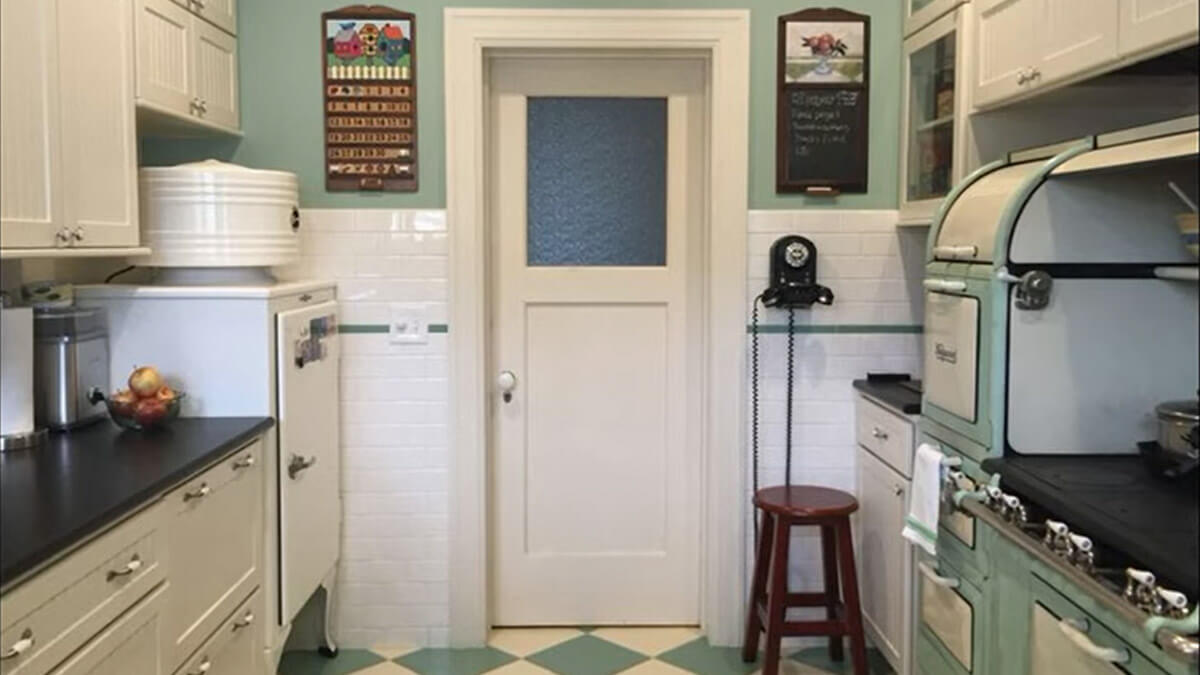
Looking back at this era, a kitchen would look as if it wasn’t well thought-out, or perhaps the technology didn’t have the right tools to make it better. Everything in the kitchen seems to be free-standing. Not because this wasn’t a good idea, the ideal kitchen back then was based on individual additions that were available at the time. By 1910, running water and ventilation were sort of a luxury.
Additions of linoleum made flooring easier to clean and added some style, but kitchen walls were essentially drab. It wasn’t until the early 1920s that cabinets were starting to be painted to add color to the kitchen. This was followed by decorative curtains and flooring to make things more attractive. There were new cabinets and sinks but these were still all free-standing and didn’t offer any kind of counter space.
It wasn’t until 1927 that many Americans eventually saw the electric fridge which replaced the icebox. This was exactly as it sounds since it’s an insulated box with real ice inside to keep food cool. Soon, wood-burning stoves would see gas-burning stoves. Electrical appliances including toasters and waffle irons were still a pricy addition for most kitchens. By the end of this decade, built-in sinks and gas ranges were a common sight.
1930-1940: The Age of Tomorrow
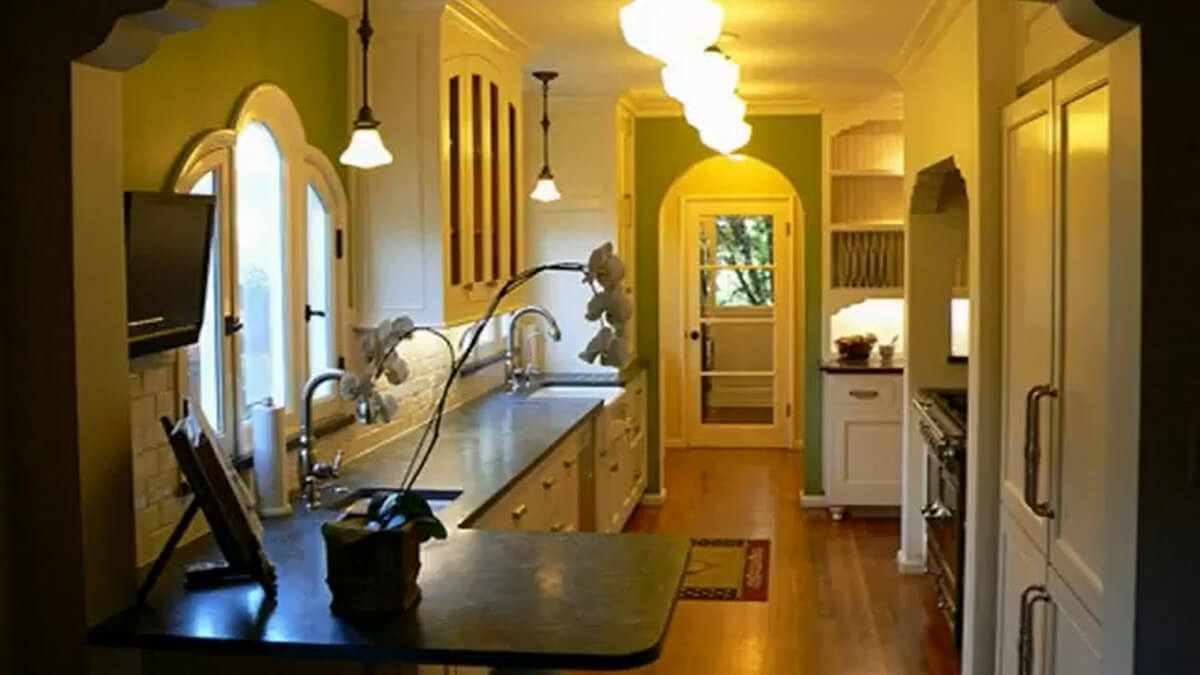
Most people don’t tell you that German culture in America inspired a lot of things, and in the 1930s, even Adolf Hitler was celebrated in America for reshaping a progressing post-WWI Germany. A new imported idea called Bauhaus (House of Building), which was a modern design school in Germany. The new radical designs that were brought over to America inspired kitchen design with countertops. The whole kitchen for that part was incorporated into this idea.
Stoves and sinks all were built into this while standing cabinets could be added or new cabinets built around this counter space concept. Unlike Europe, Americans didn’t have much need for servants, so the kitchen was designed to be efficient for a homeowner. Sinks moved closer to stoves, cabinets closer to cooking areas, and so it went… By the mid-30s, the great depression has kicked in with many families living on hard times.
If you ever wondered what inspired vivid colors in the kitchen, the age of Art Deco gave reason to make most kitchens even more welcome. Painted cabinets got richer in color and linoleum got bolder with checkerboard patterns. Popular patriotic colors like blue and red were big hits while gold was just as popular too. Additions of chrome furniture like tables and chairs gave any kitchen a modern look while colorful knobs and pendant lights added positive vibes.
1940-1950: The Self-Cleaning Revolution
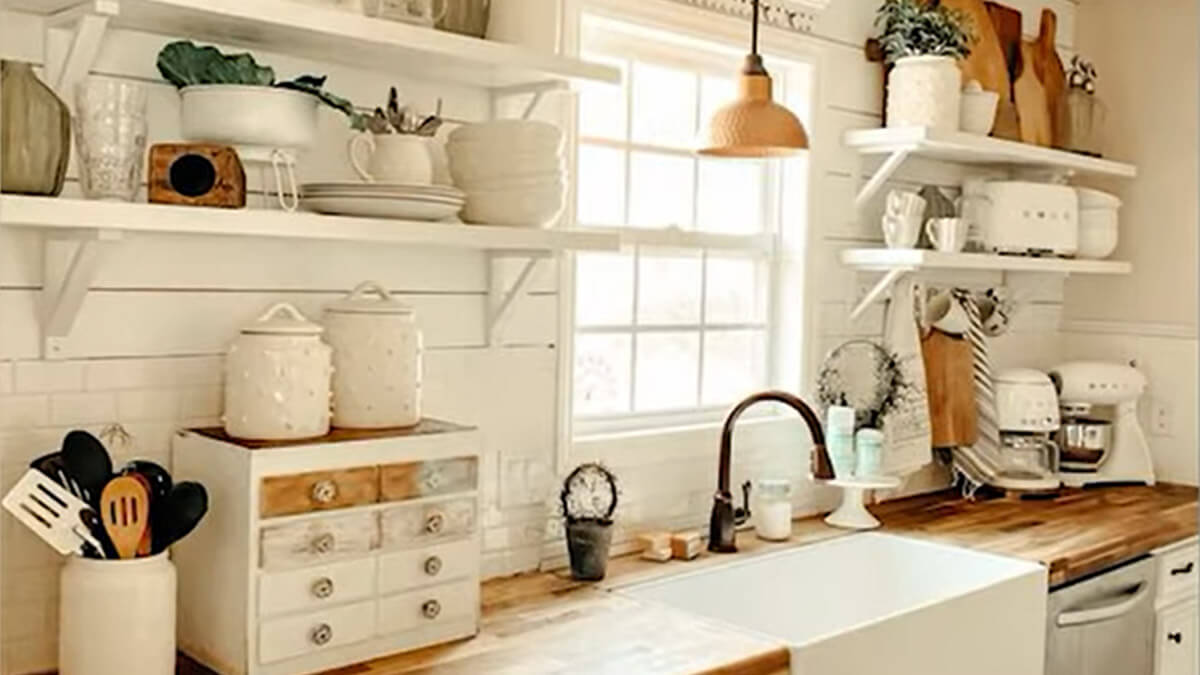
It sounds very Disney, but this decade promoted easier cleaning with the new technology. Kitchens were once again streamlined so everything could be cleaned easier with countertops made of stainless steel. Floors were widened by design to make it easier to sanitize and vacuum. The concept was now placed on the comfort of a kitchen through cleaning convenience. Most Americans would now see their kitchen as a place that wasn’t just put in the corner, but now in the limelight.
This is where many kitchens started to add décor that reminded people of better times. Adding vintage dishes onto kitchen walls or onto open shelves for display was one décor concept that began in 1943. You’ll find that many of these concepts are alive and well today featured in farmhouse style kitchens. This included embroidered curtains and even potted plants placed around the windows. Cabinets were also updated with folklore designs full of paisleys with some going so far as to add stained glass in their China clutch.
There were popular additions of furniture including chairs or couches with plaid or striped designs added into a dining area to make things more home-like around the kitchen. It wasn’t until 1947 that newer designs started to add mixing corners and prep tables for baking and mixing foods. This was also about the same time that bar stools were introduced so someone could sit at a specific spot instead of standing while they prepped food.
The revival of retro colors emerged once again but this time was reduced to pastels while were added to cabinets and countertops. Linoleum floors further added interesting colors by using Art Deco patterns of all shapes and sizes.
1950-1960: The Golden Age of Design
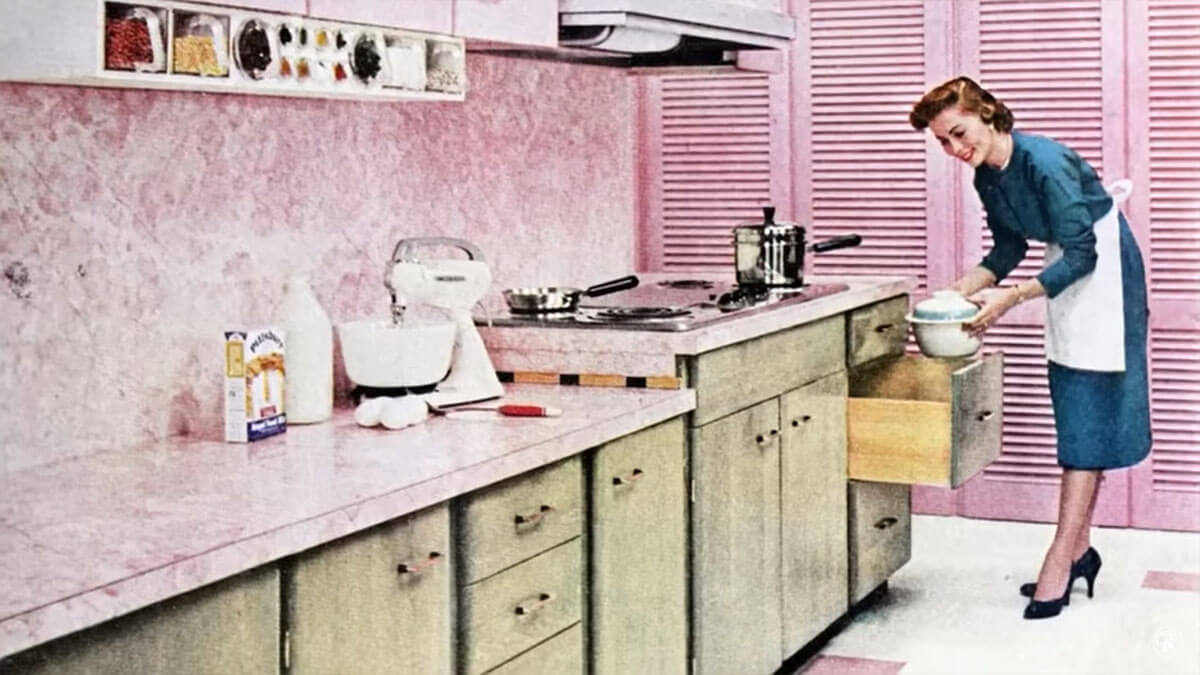
You might say this is the Golden Age of Betty Crocker, where the design of the American kitchen was pushing heavily toward making the chores of the kitchen easier for women. Added furniture became compact and was designed for being used in many ways. And though the colors stuck with pastel colors for cabinets, household appliances like stoves and fridges were garish shades that were candy-like. Fridges that were new to this era introduced glass shelves and crisper boxes.
It became more common that cabinets, countertops, sinks, and stoves were all exclusively built into the walls for ease and convenience. Around 1955, the overall design of cabinets was designed to become more space-saving without taking up more space within the kitchen. This is also when smaller tables were added inside a kitchen rather than having a formal dining room. Some smaller kitchens installed stainless steel countertops that doubled as eating areas with bar stools for seating.
With this decade ending with even more new design ideas for compact convenience, in 1957 the concept of the modern kitchen was labeled as a turning point for women in the kitchen. This idea gave American women a new level of living as the status symbol for modern life. A kitchen wasn’t considered just a workplace anymore but more or less a degree of luxury within the daily tasks of cooking for her family. As a result, these modern kitchens gleamed with polished steel and acrylic…
1960-1970: Space Race Influences
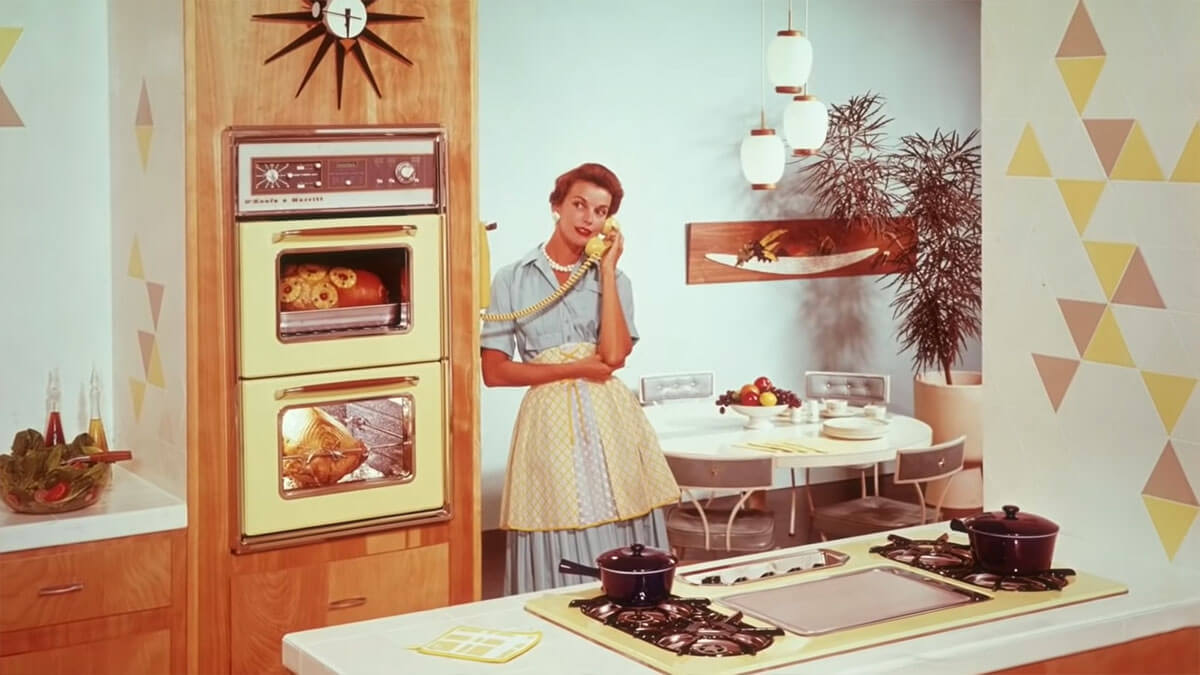
From the late 50s to the early 60s, the signs of metal cabinets weren’t so uncommon but happened to die out just like labor-saving gadgets like cake breakers and bean slicers proved to be just as useless. What the modern kitchen was aiming for was grounded more toward earth tones like avocado green and gold tones. Some homeowners were content to leave their cabinets unpainted to get more earthy wood colors instead.
As this was a time of the Space Race, the race was on in American kitchens to rocket toward less sparkle and glitter and more natural light and obviously more room in the kitchen with even more counter space than ever before. natural wood was all the rage and more kitchens began to switch over to rich grains instead of polished metal. Even the appliances like fridges and dishwashers were welcome sights for seeing wood patterns help them to blend into the kitchen geography.
What did make a significant appearance in many kitchens after 1961 was adding wallpaper which became a must. These designs include everything from a mishmash of geometric patterns to paisleys, floral patterns and leaves, and even rainbows. By 1966, the era of hippy culture was still new but probably inspired a few kids who saw these patterns growing up in a space case wallpapered kitchen. Around this time, a new addition that started using the U-Shape kitchen design was quite popular.
This gave more cabinet space and more wall space left open for wall decorations additionally. Toward the end of this decade, built-in ventilation and new refrigerators were as popular as ever. If you were doing better than others, obviously a dishwasher was included since these had been introduced a few years earlier. It wasn’t until 1967 that very wealthy families could start to include the microwave oven in their kitchen.
Another interesting breakthrough was seeing laminate being introduced in 1969 which was a new improvement for kitchen cabinets that was much cheaper than wood. This innovation would be a stable sight for nearly the next decade to come. Popular colors included green blue, grey, yellow, and white. This went well with paneling that was either meant to look like brick or other popular colors of this era.
1970-1980: A Return to Earthy Roots
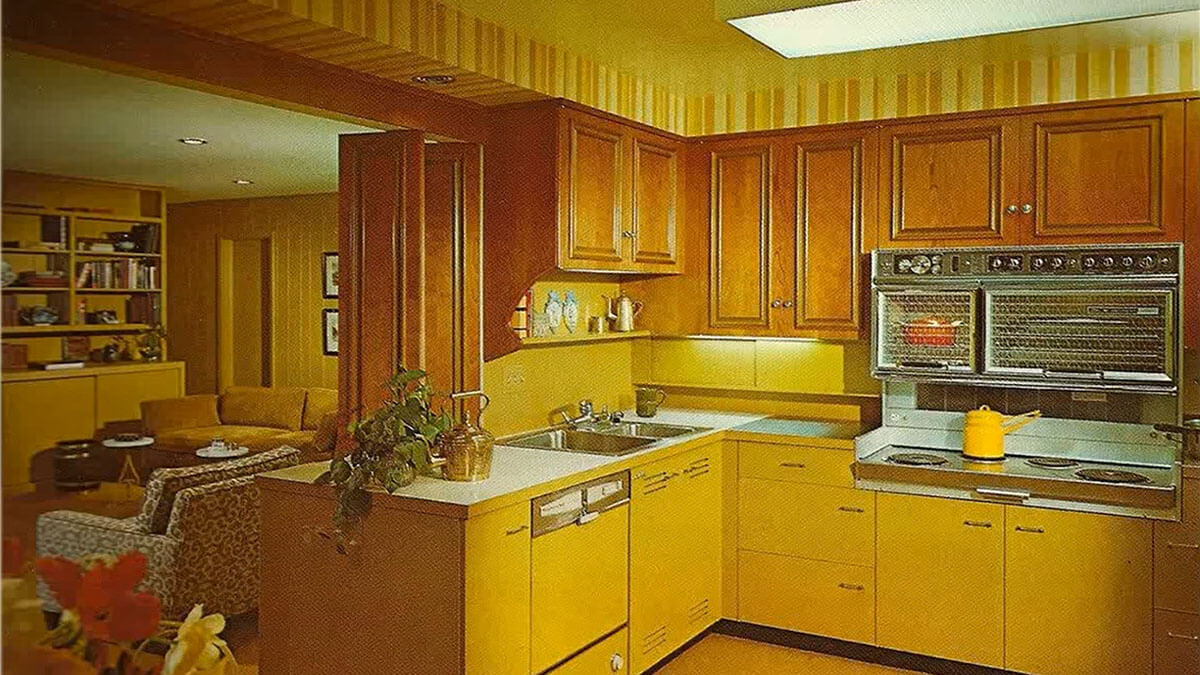
The 70s was a time of considerable change that was similar to a carnival ride that never stopped. The design of every American kitchen followed no set of rules just like the clothing and fashion of that era can recall. The one significant change was that dishwashers were built into the kitchen with countertops over them to provide more counter space. And though cabinets remained dark wood shades they were replaced with laminates that were easier to clean.
By 1975, these designs were starting to evolve into a new concept that was starting to feel more nostalgic. After all, the 1776-1976 Bi-centennial was giving new hope for creating what would be known as the country-style kitchen. Items that were considered space-age were phased out to make room for open shelving and old-fashioned values. This is when some homes started to include kitchen islands that were an echo of the past which were originally small food prep tables.
Every spot in the kitchen was decorated with baskets and bowls in addition to greenery such as potted plants. it wasn’t uncommon to see hanging decor like fruit baskets and pots and pans hanging above kitchen islands to set the tone. Ask anyone from this era about spice racks and you’ll know that these had a featured place on the walls during this time. Add a few more cooking utensils and that’s essentially how country kitchens got their start.
And though there was a very short period where laminated kitchen cabinets were still floating around, the disco era brought in wild neon colors that didn’t last long at all. In a nutshell, most American homes were late to upgrade their kitchen design until the early 80s.
1980-1990: The Contemporary Era
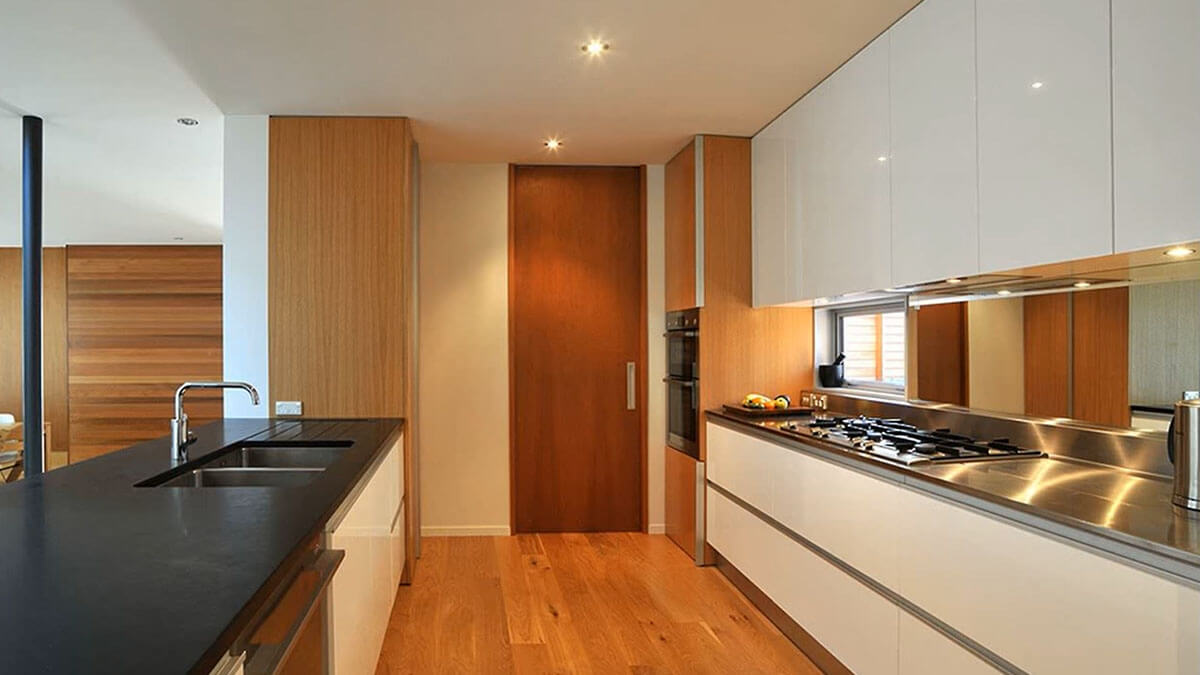
There was a huge shift in working attitudes in the 80s where both men and women hit the workplace hard -unlike previous eras. It can be said that anyone who was a ‘Yuppie’ in this generation brought in more money than in the previous decades. As a result, the kitchen was now abandoned as a family hub and returned to a more industrial workplace. Almost as if the Bauhaus design was put on steroids to create lines and definitions that took counter space lines to a whole new level.
Kitchen islands became considerably larger and the look throughout the kitchen was sleeker than ever. This is the time when Formica laminate came back stronger than ever! The appearance of everything was built to be largely hidden but served its functionality through space-saving designs. What was seen as a whole were horizontal lines everywhere complete with built-in benches and plenty of bar space. This was also the same time when pantries were added instead of cabinet space.
Pantries not only were cleverly hidden but provided more space to store supplies in the kitchen instead of taking up space in the cabinets. Kitchen islands now became more universal and would often include sinks, storage cabinets, spaces for trash, and even built-in stovetop cooking ranges. Instead of the typical dinner table, a kitchen island became an updated serving station and food prep area all-in-one.
By 1982, this is when tile counters and backsplashes were all standard additions to this style of kitchen. To break up the color scheme, many floors were famously colored Terra Cotta when wood-grain cabinets were installed. There were a lot of grey and blue accents added to give some life to kitchens that followed this theme. when 1985 came around, it was more common to see floral tiles and most of the wallpaper completely gone. The new style was becoming normal to add black and white.
Since laminates were gaining more steam by this point, the late 80s were huge for appliances that were glossy black or white so microwave ovens, toaster ovens, and juice machines all tended to blend into a backdrop of kitchen counter space. It can be considered that the late 80s became the modern design template that inspired the exact look seen if the film American Psycho.
1990-2000: Modern Meets Country
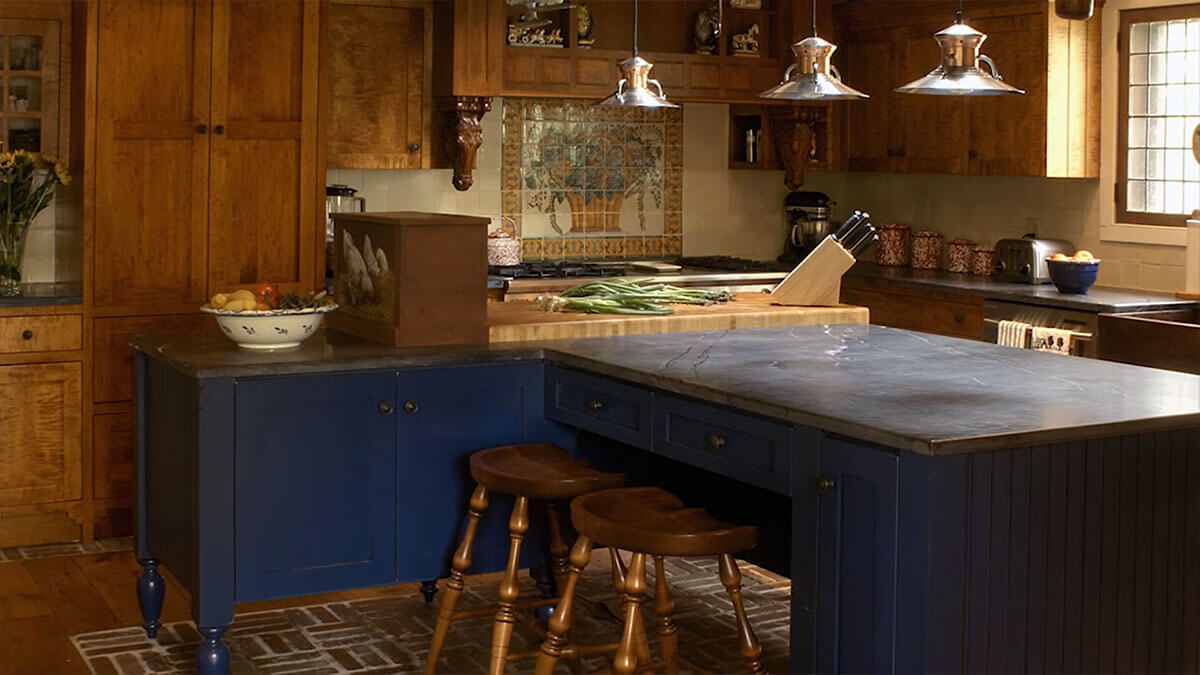
Both the style of conservative and modern kitchens started to see a departure from Formica countertops and began to incorporate heavier and more decorative materials in the early 90s. This is when granite was used extensively since it looks very similar to marble but without an expensive price tag. The most popular choice in colors included black, blue, grey, green, and white granite countertops.
There was also a movement that started to include lighter-colored cabinets and cabinets that have no visible handles. This gave the sleek appearance of modern cabinets a more seamless flow and wouldn’t draw your attention away from the lines that were present, you might have guessed, this would carry on as a design rule from this point. This was also updated further by the return of white kitchens which gave everything a clean look.
When 1994 rolled around, many American kitchens had ditched their concept of wallpapered kitchens for conservative or modern designs, however, there was another style that was creeping back in that was bigger and better than the 1976 revival of country kitchen design. It seems that a whole new concept called farmhouse kitchens was being introduced that mixed French and English countryside houses and cottages.
This included the addition of apron sinks, light-colored wood cabinets, brass and copper utensils and accessories, and cast iron decor. Some designers went even further by adding China hutches that had cabinet doors with glass with every color in the kitchen emitting an earthy tone of beige and light green but sometimes colonial colors like grey and light blue. Backsplashes were exceptionally tiled to match the granite counters of various mosaic patterns.
2000-2010: The Supersized Kitchen
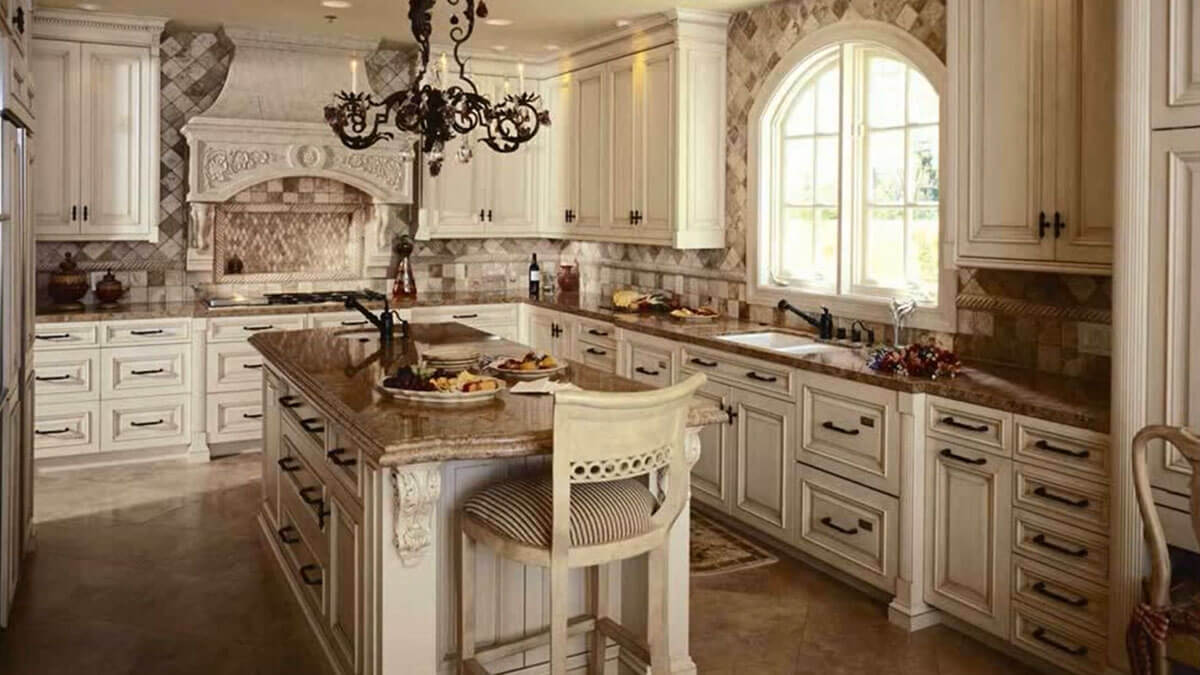
Just as McDonald’s had introduced the supersize meal menu option, this was the case for what became known as Mc’Mansion kitchens that took advantage of every bit of room a kitchen could offer and much more… Entire kitchens were expanded for show with wall-to-wall counters, dining table-sized kitchen islands, and walk-in pantries galore. Designers now began to explore the concept of kitchen themes that hadn’t been attempted before and were ramping up to become a religion.
Farmhouse kitchens could easily see a dramatic transition into more exotic themes such as Tuscon and Mediterranean themes involving decorative wood moldings and rustic décor. Appliances like fridges and stoves noticeably were all stainless steel finishes since these surfaces would reflect everything around them. There was also a return of handles and knobs that gave cabinets more style and charm completing the ornate themes that were created.
Despite the popularity of modern kitchen designs, these slowly dialed back into conservative kitchens to appear more home-like and appealing to families that were settling into their newfound career success. As the era of the internet was taking off like crazy, conservative ideals were beginning to emerge for more family-oriented kitchen spaces.
2010-2020: Heart of the Home
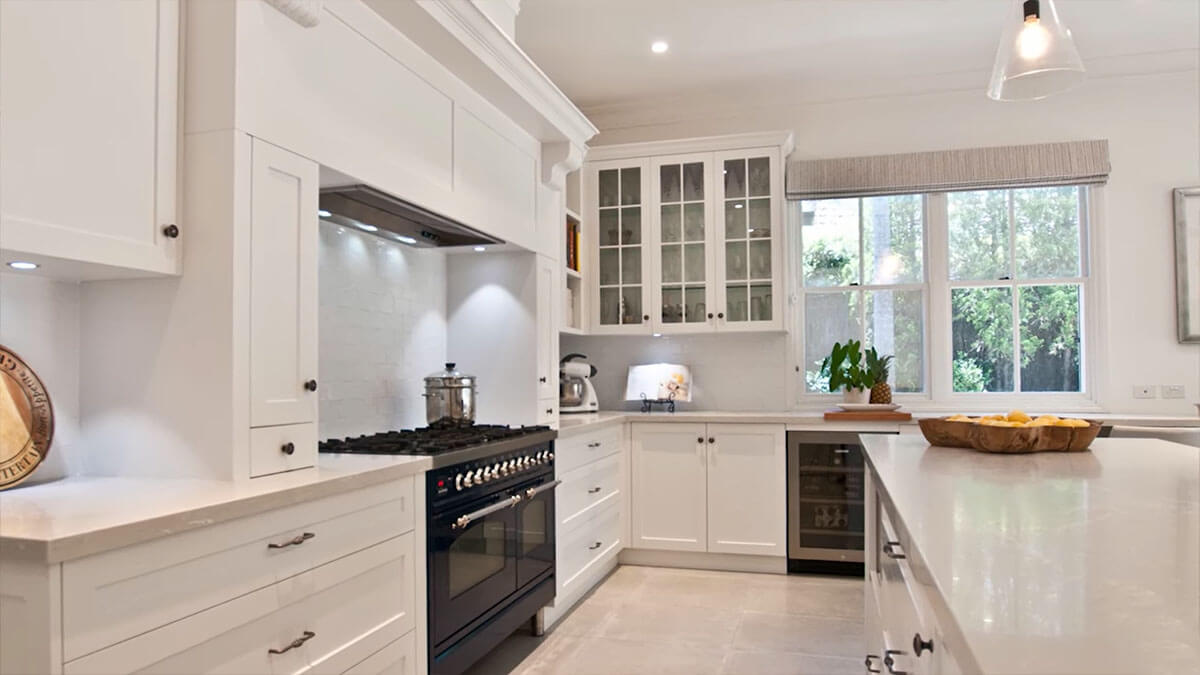
As there were advancements in the internet, the popularity of sharing everything online became a daily part of our lives. The look of a kitchen had now become an extension of ourselves with every style being shared with others. Although this didn’t exactly start a war, it further proved that you can’t be limited with a kitchen design theme. White kitchen designs soon extended into countertops that featured quartz.
Entire kitchens were flooded with light to create an almost dreamlike place where magic is made. Yet, some kitchens returned to basics by adding wallpaper and accent walls instead of painted surfaces. Every item in the kitchen was now selected so it would stand out as a conversation piece. Lighting above kitchen islands now framed these areas as meeting and socializing points rather than just family meals.
And among the various styles that every American home would include, each kitchen was as individual as the next. Pendant lighting wasn’t just an option anymore as these fixtures provided personal touches of beautifying and pleasing the senses. But as you already might have guessed, every decade typically returns to simplicity that may very well be returning soon enough. Perhaps we will see even further versions of the farmhouse or country kitchen evolving further?..
Reflecting on the Evolution of the Kitchen

So, when you think about it, the transformation of kitchens over the years is pretty fascinating; we’ve gone from basic, utilitarian spaces to what we have today—the genuine heart of the home. And let’s face it, kitchens are way cooler now. They’ve got all these smart gadgets that make life easier, plus they look great. It’s like blending style with substance.
Modern kitchens are all about efficiency and convenience, but they’ve also got this cozy vibe where everyone likes to hang out. It’s not just about cooking anymore; it’s where we gather, chat, and share good times. Plus, there’s this whole eco-friendly angle now—people want kitchens that are not just smart but kind to the planet. So, yeah, kitchens today are pretty awesome. They’re more than just a place to whip up a meal; they’re where memories are made and cultures come alive. They’ve become a central piece of the American Dream.
What will the kitchens of tomorrow hold? Only time will tell, but one thing is certain—the heart of the home will always be a place of warmth, creativity, and community.

























No comment